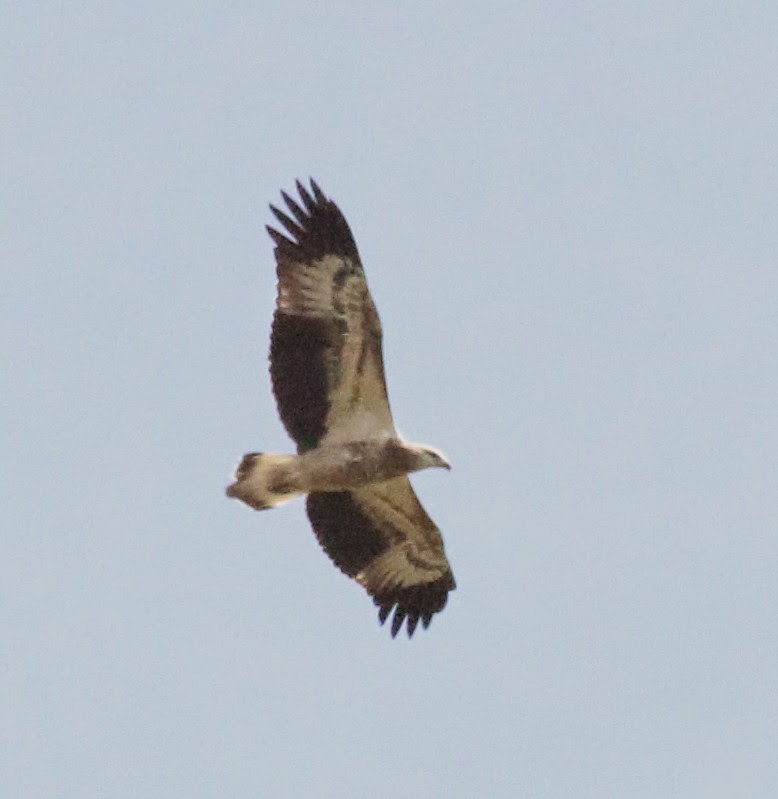Whenever i see a cuckoo i would try to take lots of their images as possible. They are after all one of those 'difficult' birds to be identified. You do not need to have great photos of the bird but as long as the subtle/prominent features can be seen you should be able to identify them or perhaps with some help from an experience birder. I went again to Air Itam Dalam instead of Sungai Sedim forest recently in view of the weather and its shorter distance from my home. There are always some aura of mystery at this place i.e you will always expect to see something different each time you step into the area. This time three types of cuckoos were seen, however only two species were photographed. The first been an Indian Cuckoo.
According to Craig Robson's (2005) and Allen J's (2012) field guide, a female Indian Cuckoo has rufescent wash / rufous tinge across breast. Here you can see the feature and therefore the image suggests that it could be an adult female Indian Cuckoo.
According to Medway and Wells (1976), this cuckoo species is most active from January to August but since this cuckoo was seen in December so it might just be an early visitor here.
In flight i have noticed that it has quite sharp arched wings, something which you will also see in 'Nightjars', 'Frigate birds' etc. This bird was silent through out which would normally be expected of passage migrants/winter visitors.
It was also quite aggressive - chasing a 'Common Flameback Woodpecker' (Dinopium javanense) straight down to the water. I believe it may be trying to prevent the woodpecker from getting near to the 'Pin-Stripped Tit-Babblers" (M. gularis) which a few have been observed near the Indian Cuckoo and may be presumed looking for a suitable nesting site.
The second cuckoo bird seen here was even more interesting and it was presumably an Oriental Cuckoo ! Ever since King (2005) described the oriental cuckoo (Cuculus optatus) as two separate species i.e Himalayan Cuckoo (C.saturatus) and Lesser Sunda Cuckoo (C. lepidus), the taxanomy of this cuckoo species has yet to be confirmed until todate. A quick check on Birdlife International site reveals that the oriental cuckoo (C. optatus) taxon is no longer recognised. However most of the checklist available todate and at the point of typing recognised C.saturatus (Himalayan Cuckoo) and Sunda Cuckoo (C.lepidus) in their database. Here are the latest checklist which you can refer to:
The second cuckoo bird seen here was even more interesting and it was presumably an Oriental Cuckoo ! Ever since King (2005) described the oriental cuckoo (Cuculus optatus) as two separate species i.e Himalayan Cuckoo (C.saturatus) and Lesser Sunda Cuckoo (C. lepidus), the taxanomy of this cuckoo species has yet to be confirmed until todate. A quick check on Birdlife International site reveals that the oriental cuckoo (C. optatus) taxon is no longer recognised. However most of the checklist available todate and at the point of typing recognised C.saturatus (Himalayan Cuckoo) and Sunda Cuckoo (C.lepidus) in their database. Here are the latest checklist which you can refer to:
i) Avibase database - version May 2014
ii) Birdlife International - version 06.1 (Feb 2014)
iii) Clements - 6th ed., (6.9), 2014
iv) eBird - version 1.55
v) Howard & Moore - 4th ed.
vi) IOC World Birdlist - version 4.04
Note: apparently the above checklists also have "C.optatus' in their listing ! Aduh ! PENING KEPALA !!
Note: apparently the above checklists also have "C.optatus' in their listing ! Aduh ! PENING KEPALA !!
Could this be a Himalayan Cuckoo (Cuculus saturatus)?
Just like the Indian Cuckoo it had remained silent but it perched quite high up on an exposed trunk. Due to the weather condition, i had to increased the ISO metering to see its features otherwise it would just appear as a black dot on the screen! According to Wells & Becking (1975) and Payne (2005) as cited in {Lindholm and Linden (2007), Forktail 23: 12 -16}, the Sunda Cuckoo occurs as a resident on the Malayan Peninsula and Indonesian islands. In more recent times, Allen J (2012) described that migratory population tend to frequent low elevations. So this cuckoo at Air Itam Dalam area may had been from the northern migratory populations (i.e from Central Asia, the Himalayan mountains, Japan and China) because the resident population in Peninsular Malaysia usually occurs above 900 m (Allen J & Pearson, 2012). (Note: it was reported that Seberang Perai area which consists of Air Dalam Forest is only 541 meters above sea level)
If this was indeed C. saturatus or a C. optatus then it should be the first reported sigting at Air Dalam Forest and probably just one of a few been spotted outside its hill or mountain playgrounds (as per B.i.W record). Although DNA analysis has been recommended to scientifically identify this species but how i wish that this cuckoo bird can be described as how some Malaysian birders described Swinhoe's snipe (G. megala) and Pintail snipe (G.stenura) as "Swintail Snipe" !! Malaysia Boleh ! I am sure you can too !
If this was indeed C. saturatus or a C. optatus then it should be the first reported sigting at Air Dalam Forest and probably just one of a few been spotted outside its hill or mountain playgrounds (as per B.i.W record). Although DNA analysis has been recommended to scientifically identify this species but how i wish that this cuckoo bird can be described as how some Malaysian birders described Swinhoe's snipe (G. megala) and Pintail snipe (G.stenura) as "Swintail Snipe" !! Malaysia Boleh ! I am sure you can too !

















































































